Tamilnadu Temples
For Temple Tours CLICK HERE
Tamilnadu Murugan Temples
Lord Murugan is known and worshiped by several other names like Murugan, Skandan, Kartikeyan, Subramanyan, Sengalvarayan, Swaminathan and so on. Kaumaram is one of the divine religion identified by Adi Sankaa. He is also a Valiant Warrior incarnated to cleanse the world from the atrocities of the Demons. Apart from the Six Special Abodes of Lord Murugan Thirparankundram, Tiruchendur, Palani, Swamimalai, Thiruthani and Pazhamudhircholai called the Arupadai Veedu , the State has many important temples dedicated to Lord Murugan. They speak of the rich Religious, Cultural and Architectural heritage of the land. Over the years, the sculptural skills of the craftsmen have reflection in these temples.
Thiruthani
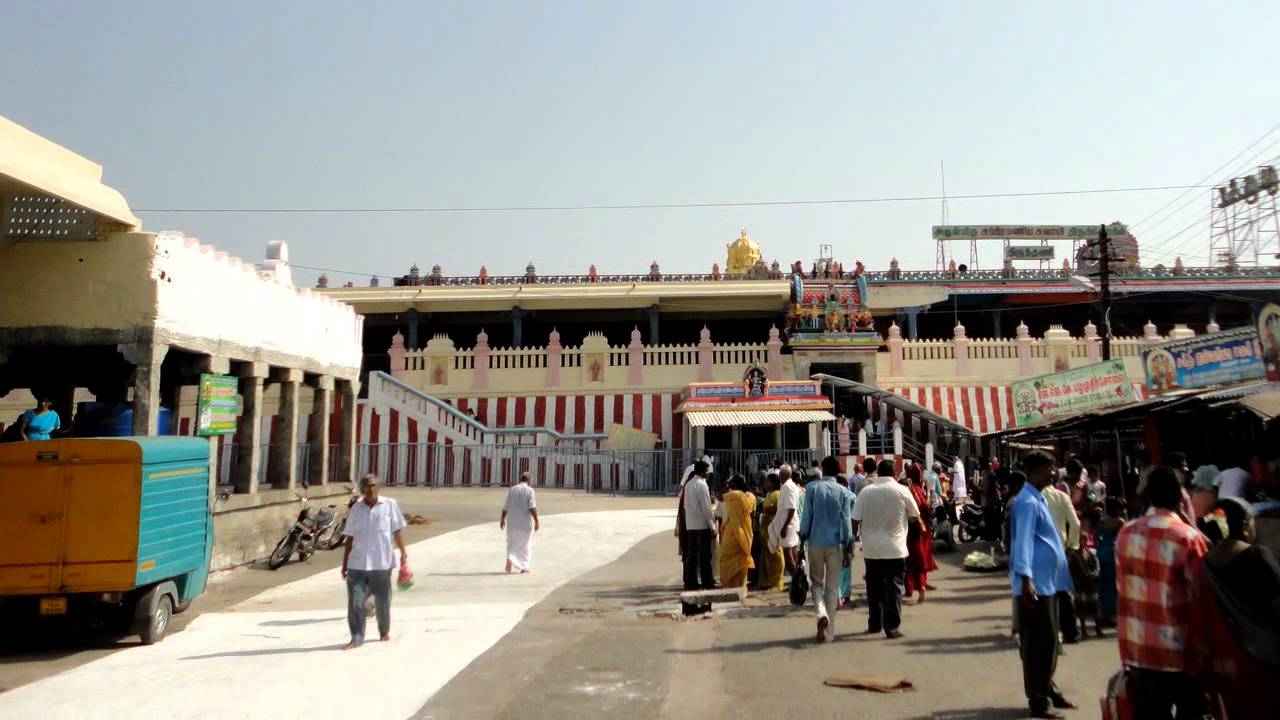
It is 87 Kms from Chennai and 15 Kms from Arakkonam Junction. The temple is located on a small hillock, with wide and winding 365 steps, each symbolically represent 365 days of the year. Lord Murugan is seated with his Consort Valli, whom he accompanied from Vallimalai and the celestial Wedding between them took place at Thiruthani.
Swamimalai
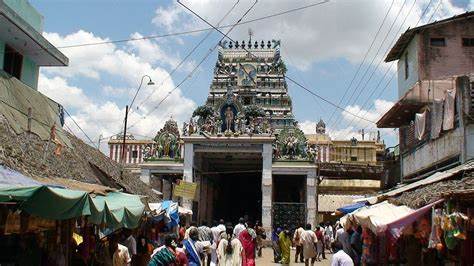
It is 45 Kms from Thanjavur and 10 kms from Kumbakonam. This temple is located on a small hillock with 6o steps which represent 60 Hindu Years cycle. In this holy place Lord Murugan is said to have taught the meaning of pranava mantra OM to his father, Lord Siva.
Thiruchendur
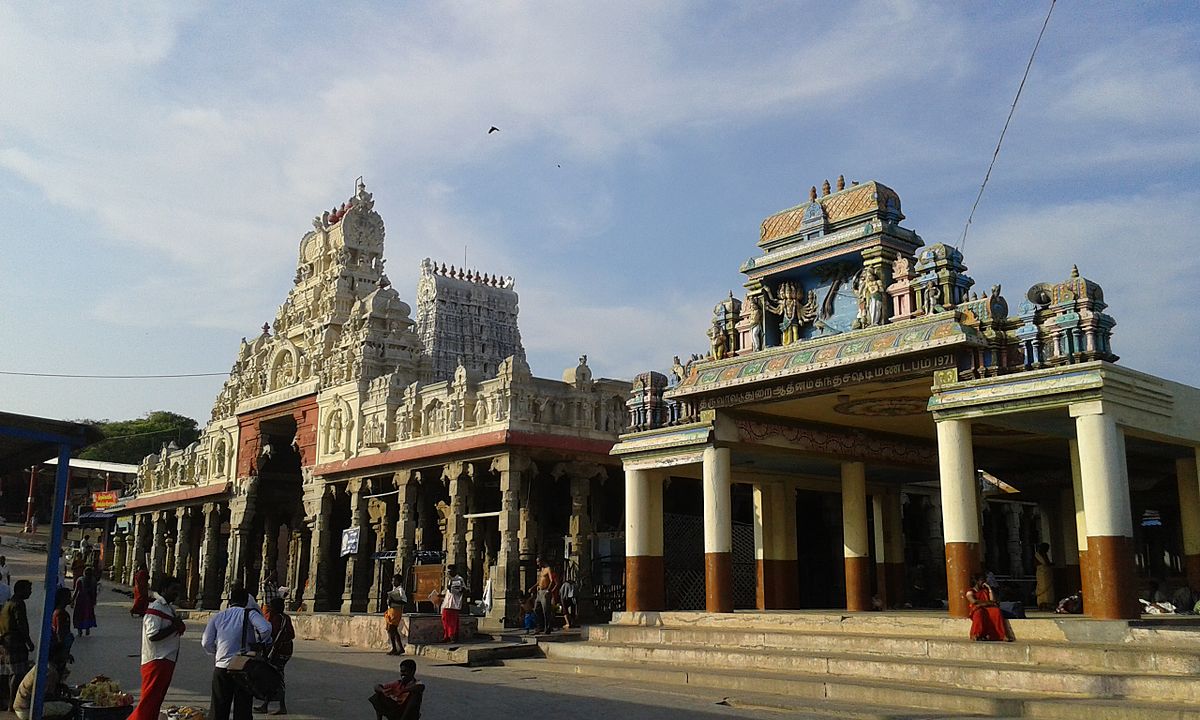
It is 48 Kms from Tirunelveli. This temple is 2000 years old. Lord Murugan in this temple is in a different posture, holding a string of Rudraksha beads instead of usual spear . The reason cited for this is that, for he worshipped Lord Shiva in this temple. Skandha Sashti is the most popular Annual Festival of this temple. It is during this festival, the devotees enact the Killing of Demon Sooran, and the event is called Soora Samharam.
Pazhamudhir Solai
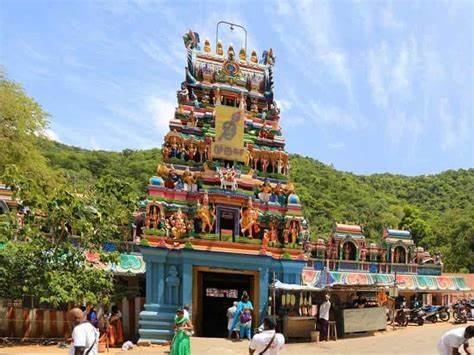
Located 16 Kms close to Madurai. This temple dates back to several hundred years. Nakkirar, Arungirinathar and Avvaiyar are among the several Tamil Saints who have made references of this shrine in their hymns and literary work. Legend is that: Lord Muruga appeared before Avvaiyar as a playful young boy to test her.
Thirupparam Kundram
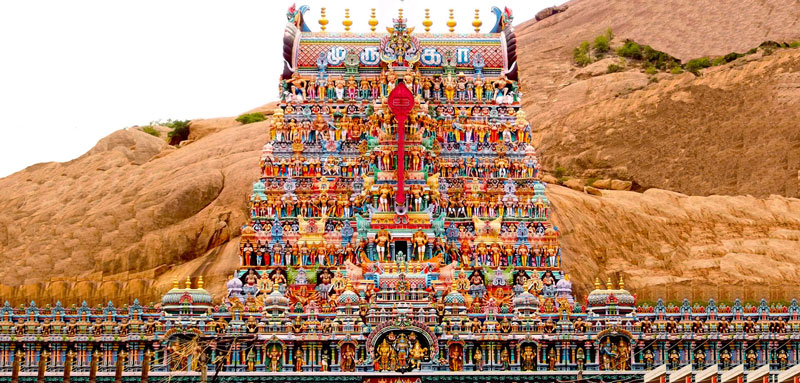
Located 8 kms from Madurai, This abode of Lord Murugan is noted for its inner sanctum sanctorum that is cut out of single hard rock. Lord Murugan together with his consort Deivayanai blesses his devotees. The main temple was a cave shrine earlier. Rest of the structure datesback to the Nayak period.
Palani
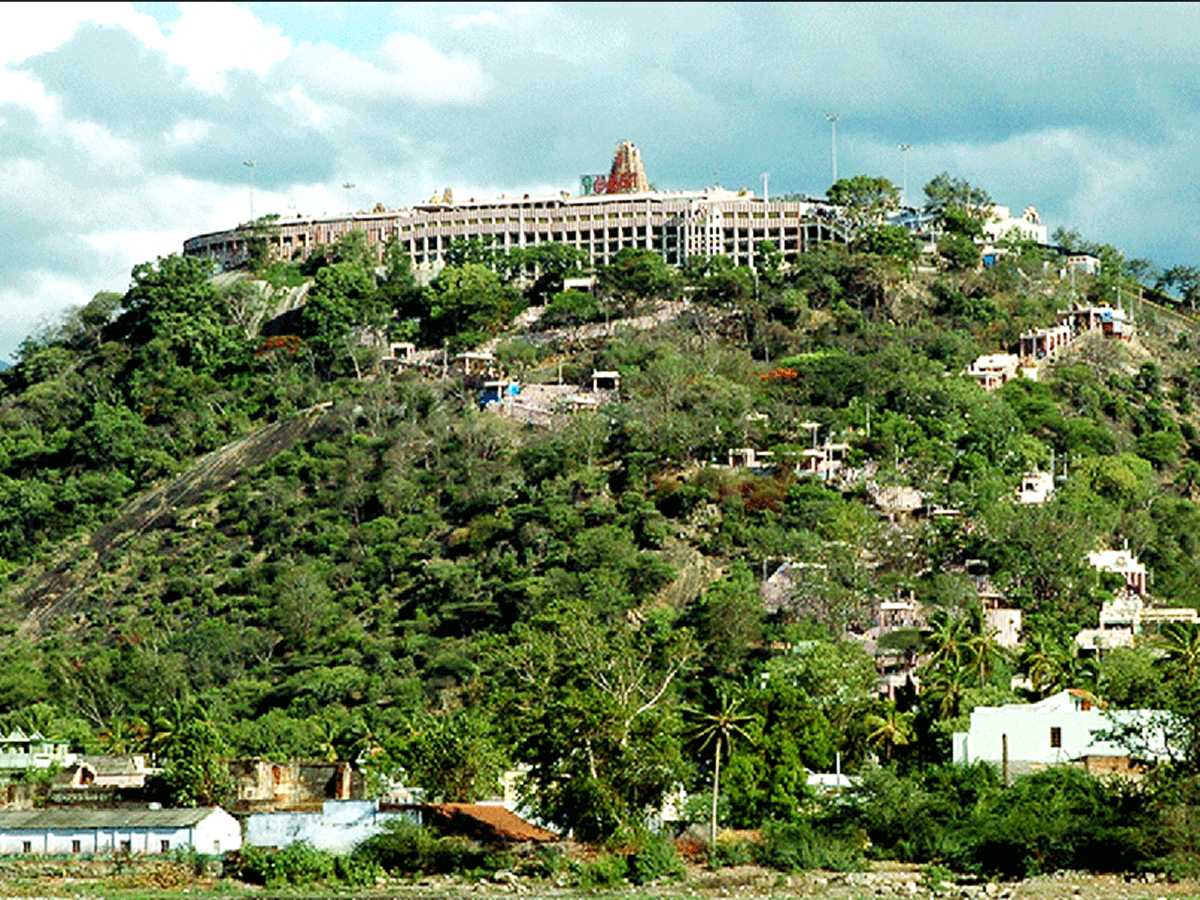
Located 120 kms from Madurai, in the district of Dindugal. This is one of the most hallowed shrines of Lord Murugan. The name is a lateryears coinage. The name pazhani comes out of Tamil words, Pazham + Nee [your are the fruit]. The idol of the Lord Murugan in Palani, was created and consecrated by sage Bogar , one of eighteen great siddhars out of an amalgam of navapashanam or nine herbal combination. The temple is visited by more than 7 million pilgrims each year.
Other than the list of the above Arupadai Veedu Murugan Temples; Tiruporur, Kandakottam, Ettukudi, Enkann, Sikkal,Chennimalai, Kundrakudi, Marudamalai, Mavadipuram, Nallur, Pachamalai, Thindamalai, Vallimalai, Vayalur, Viralimalai are very important Murugan Temples of Tamil Nadu.Tamilnadu Navagraha Temples
Believers in astrology and the influence of planets over individual destiny will find Tamil Nadu as a Great Destination. Indian Astrology believes that the planetary positions of the nine planets in a geocentric orbit determine the strength and weaknesses of a life , and how it takes its course Nava means Nine and Graha means Planets. Navagraha temples devoted to the Nine Celestial bodies, with incarnation of God for each of those nine planets are found in and around Kumbakonam and Thanjavur District.
Planet - Temple Surya (Sun) - Suryanar Koil Chandra (Moon) - Tingaloor Koil Chevaai (Mars) - Vaitheswaran Koil Budhan (Mercury) - Tiruvenkadu Guru (Jupiter) - Alangudi Shukran (Venus) - Kanchanoor Shani (Saturn) - Tirunallar Rahu - Tirunageswaram Ketu - KeezhperumpallamSuriyanar Kovil
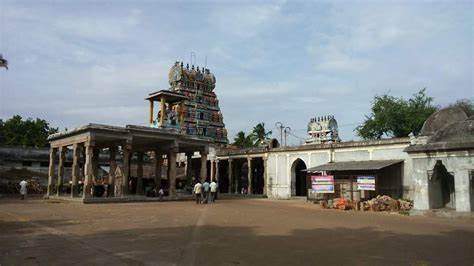
This temple 21 Kms from Swami Malai and 58 Kms from Thanjavur, believed to have been built by Chola King Kulothunga I in 1100 AD, is dedicated to Lord Suriyan [Sun] . Suriyan is believed to bestow health, success and prosperity. The Pongal Festival is celebrated as Harvest Festival and Thanks giving to Lord Suiyan.
Thingalur Kovil
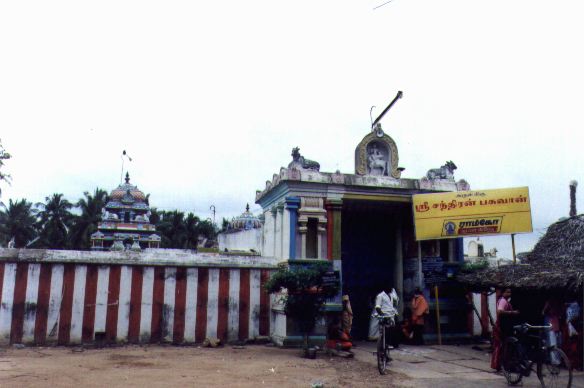
It is 18 Kms from Thanjavur on the Thiruvaiyar – Kumbakonam route. This temple is believed to be existing even before 7th Century and it is one of the Navagraha Temple dedicated to Lord Chandran [Moon] in the planetary formation. Chandran is said to be the reliever of Stress and Sorrow.
Vaitheswaran kovil
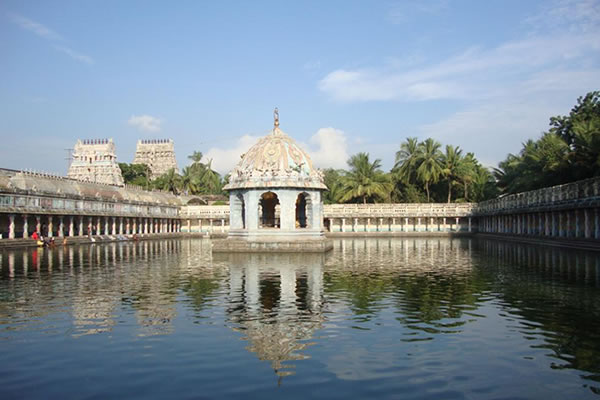
It is 90 Kms from Thanjavur on the way to Chdiambaram. This temple is dedicated to Navagraha Temple dedicated to Lord Sevvai / Angaragan [Mars] in the planetary formation. Lord Angaragan is believed to bestow Valour, Victory and Strength. The Devotees take dip in Sidhamirtham Tank as the water in tank is said to have the curative powers for various skin ailments and also believed that a visit here removes all the obstacles in the delay of marriages for both men and women.
Thiruvenkadu
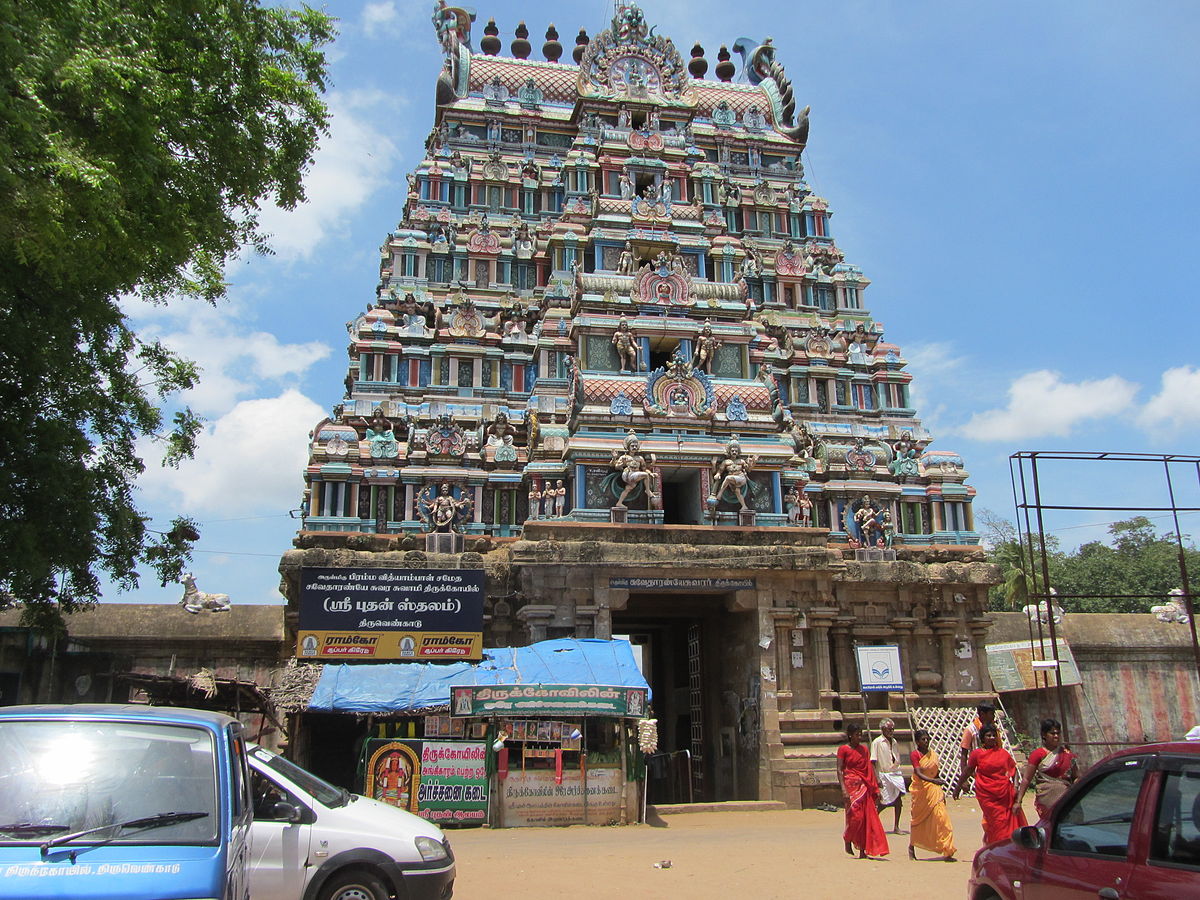
It is near Mayiladuthurai. This is one of the Navagraha Temple dedicated to Lord Budhan[Mercury] in the planetary formation. This temple has reference in Valmiki Ramayanam too and believed to be over 3000 years old. Lord Budhan is said to bestow wisdom and intellect.
Alangudi
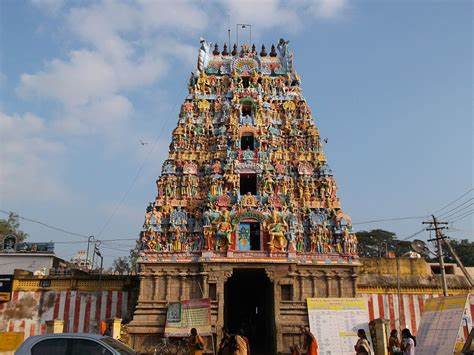
This temple is 36 Kms from Thanjavur and dedicated to Lord Guru [Jupiter]. He is also called as Brihaspathi. He is worshiped by students for their excellence in education, fine arts and wisdom. This temple attracts a large number of devotees when Jubiter transits one Zodiac sign to another. It is believed that Goddess Parvati was reborn on the banks of Amrita Pushkarani, a divine tank within the temple precincts before being reunited with Shiva.
Thirunallar
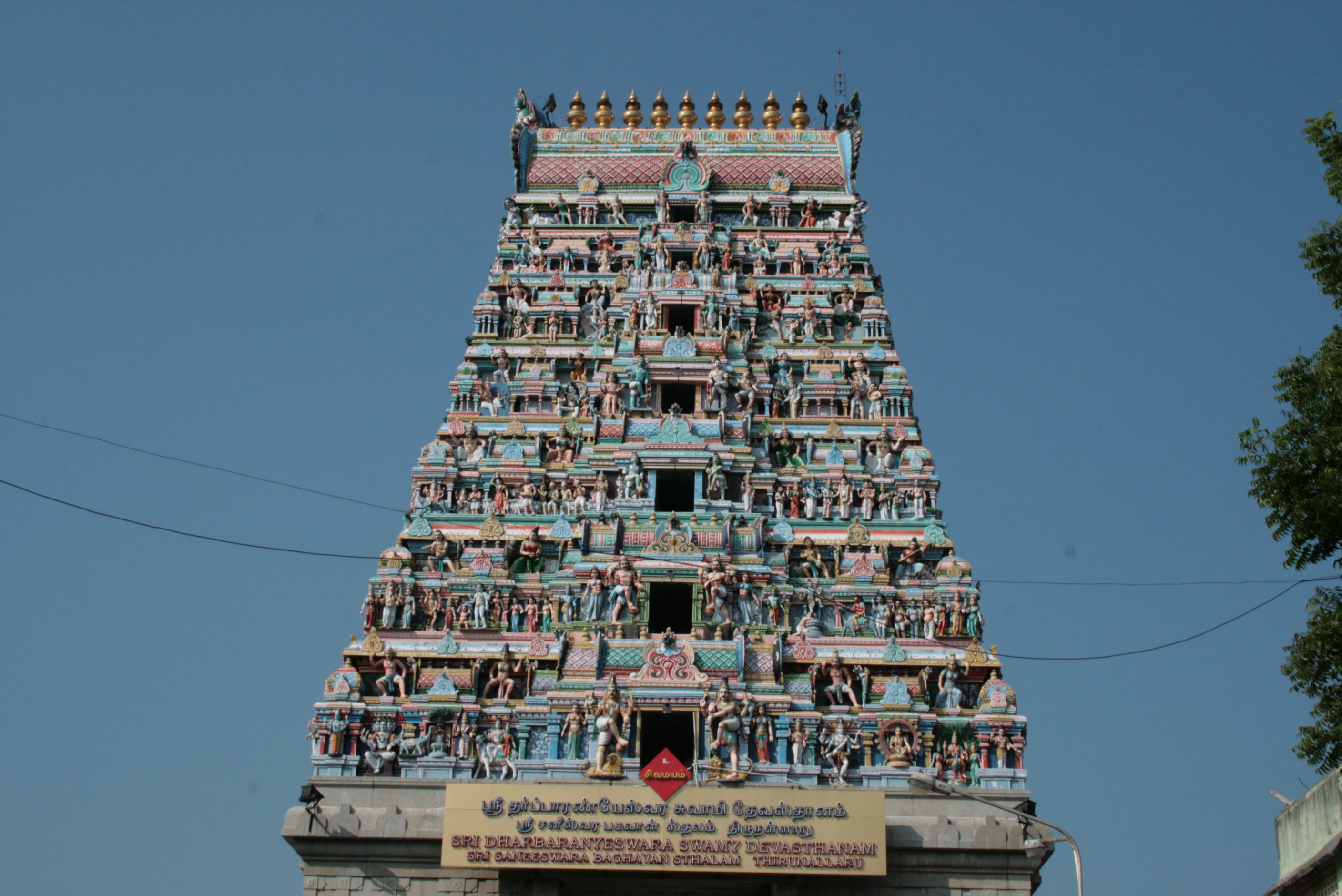
It is 90 Kms from Thanjavur and 35 Kms from Mayiladuthurai and nearer to Karaikal.. This temple is dedicated to Lord Saneeswaran [Saturn]. He occupies the most important position in the planetary position. Anybody who worships him is believed to be relieved from curses, spells of ill luck and diseases. Legendry King Nala is said to have been relieved of all obstacles due to malefic influence of Saturn. Of the holy tanks around the temple , Nala Theertham is one of the important tanks where all the devotees take a holy dip to get relieved of all misfortunes and afflictions.
Kanchanur
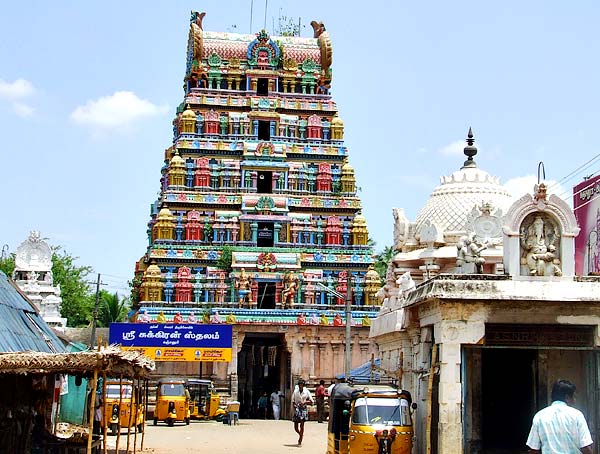
It is located 57 Kms from Thanjavur on the way to Mayiladuthurai . This temple is dedicated to Lord Sukran [Venus] whose duty in the planetary position is to solve problems related to love, marriage, beauty and comforts. This temple is maintained by Madurai Adhinam located at Thiruvavaduthurai. It is also called Palaasavanam, Brahmapuri and Agnisthalam. Sukran is believed to be prayed by men folk for the well being of their wives.
Thirunageswaram
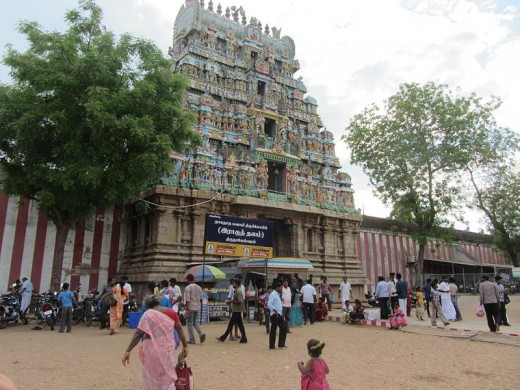
It is 6 kms from Kumbakonam in Thanjavur District. This temple is dedicated to Lord Raghu. The legend says the Serpant Adi Sesha , Dakshan and Kaarkotakan worshipped Lord Siva here. This locality is identified with champakaranya. Devotes throng this temple to get relieved of Naga Dosham.
Keezhperumpallam
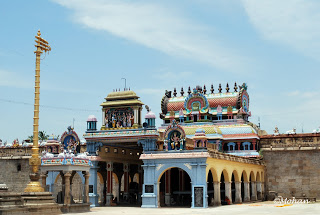
This is a Siva temple located close to Poompuhar and Lord Kethu is enshrined within this temple. The legend records that Kethu worshiped Lord Siva here. Rahu and kethu are believed to have associated with the legend of the serpent that helped Lord Shiva Churn the Milk Ocean(Paar Kadai).
Madurai Temples
The Meenakshi Temple
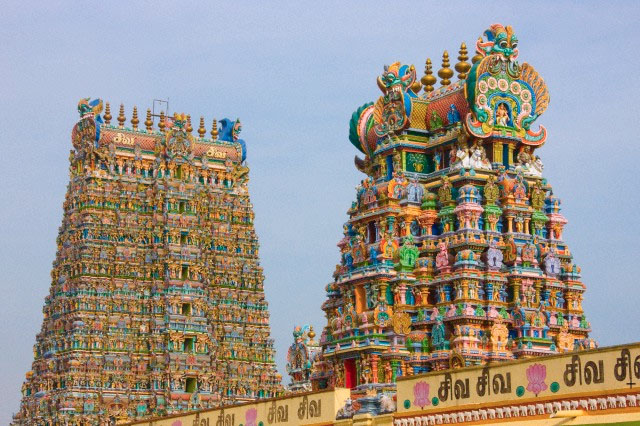
It is the elegant twin temple of Sundareswarar and Meenakshi and the life of Madurai City revolves around this temple. The construction process of the temple began 2000 years ago. Contributions from different rulers and special contribution from Thirumalai Naicker, made this complex to extend by leaps and bounds over an area of 65000 sq.m and people rightly call this temple complex as a City of its own. Four Nine tier Gopurams, One Seven tier Chittirai gopuram, Five numbers of Five Tier Gopurams, Two Three Tier Gopurams and Two Golden Gopurams are the majestic towers of the temple. Because Golden Lotus for Indira’s Puja blossomed in the tank inside the temple, it is called as Golden Lotus Tank [Pon Thamarai Kulam]. The Hall of Thousand Pillar of the Thirumalai Naicker period is called as Ayiram kaal Mandapam in Tamil. The architectural excellence of this hall is that the pillars viewed from any angle will be on a straight line. The musical pillars carved out of stone decorate the corridors of the outer courts. Temple is open between 5.00 am and 12.30pm :: 4.00pm to 9.30pm.
Koodal Alagar
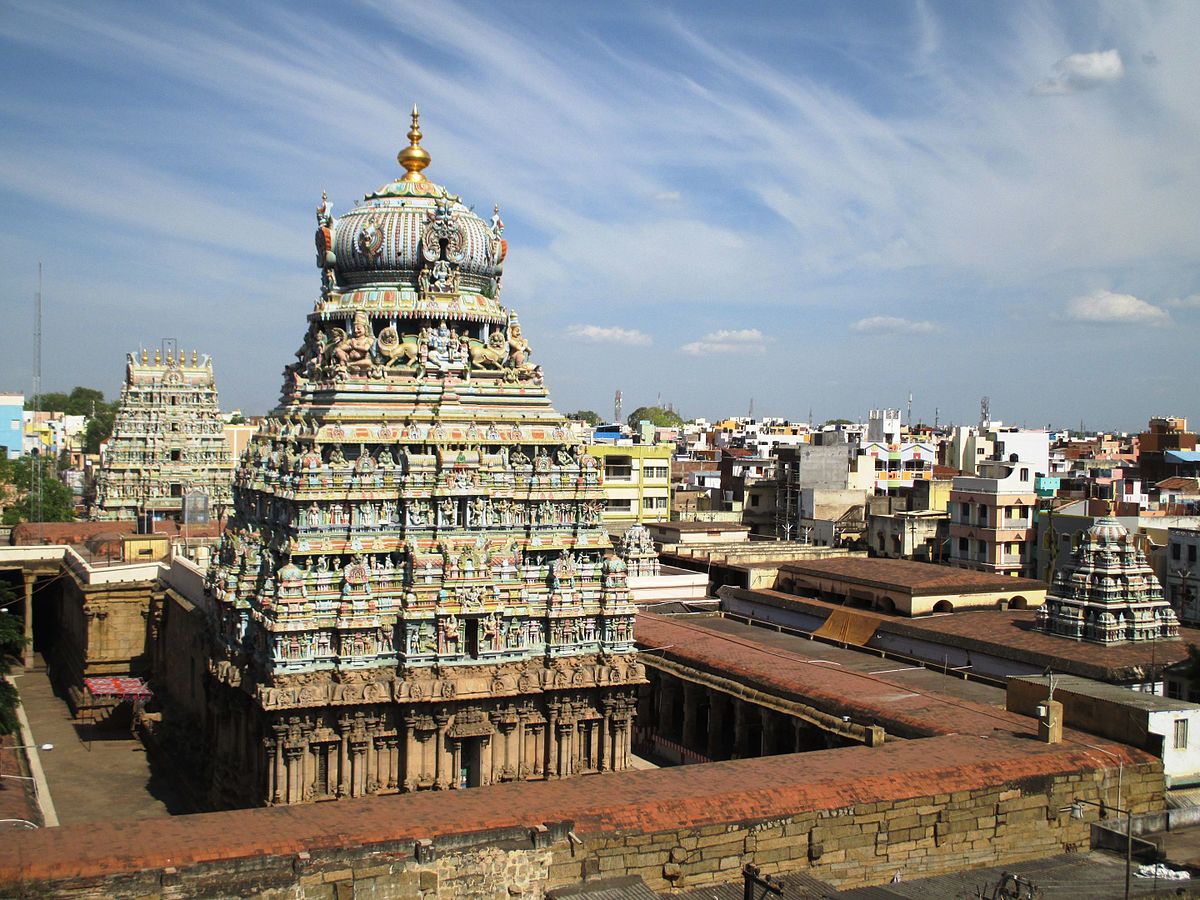
This is a temple in the heart of the City, dedicated to Lord Vishnu and one of the 108 Divya Desams. Koodal is another name for Madurai and Azhaghar means The beautiful hence he is called Koodal Azhagar. Koodal Azhagar in three postures: in Sitting posture as Koodal Azhagar , in Standing Posture as Sri Surya Narayanan, and Sri Ranganatha in Reclining Posture[ Lying down] are in three separate Sanctum Sanctorums one above the other. Convenient steps have been provided to reach all the floors. The shadows of Ashtanga vimanam ( tower ) do not fall on the ground. Lord Azhagar is taken on procession for a dip in the Vaigai River on the Chitra Paurnami Day [ Full Moon Day – Apr-May] is the most colourful festival that brings the entire Madurai Town to Stand Still. A 10 day float Festival is celebrated in the month of Masi [Feb-Mar] on the Masi Magam[star] day.
Mariamman Theppakulam
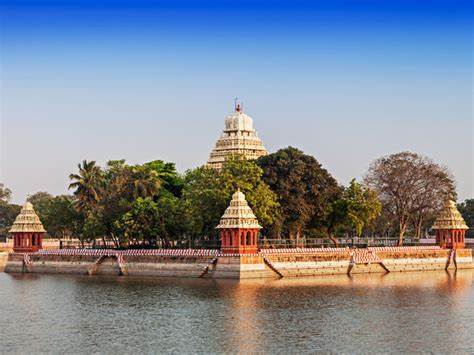
It is also called as Vandiyur Mariamman Teppakulam just 2 kms from Meenakshi Temple in the Town. Well laid out Underground water Channels connect this Vandiyur Mariamman Teppakulam. It has 12 step Ghats on all four sides of the 16 acre Teppakulam measuring almost 300 meters by 300 meters in size. It is said that, this pit was dug to fetch sand to build Thirumalai Nayakar Palace. The pit was later converted with brick work as a Holy tank and Thirumalai Nayakar Built the Vandiyur Mariamman Temple too on the northern side of the tank. In the middle of the tank there is a Mandapam called Maiya Mandapam [center Mandapam] with a small Vinayagar Temple and a Garden. The Float Festival at Mariamman Teppkulam one of the most colourful temple festival, annually held in the month of Thai [Jan-Feb] to mark the birth anniversary of King Thirumalai Nayak. Goddess Meenakshi and Lord Sundareswarar are seated on an illuminated Float [Theppam] colorfully decorated with flowers and the Theppam moves around the tank with the traditional musical treat in the background, watched by thousands of devotees.
Thiruparangundram
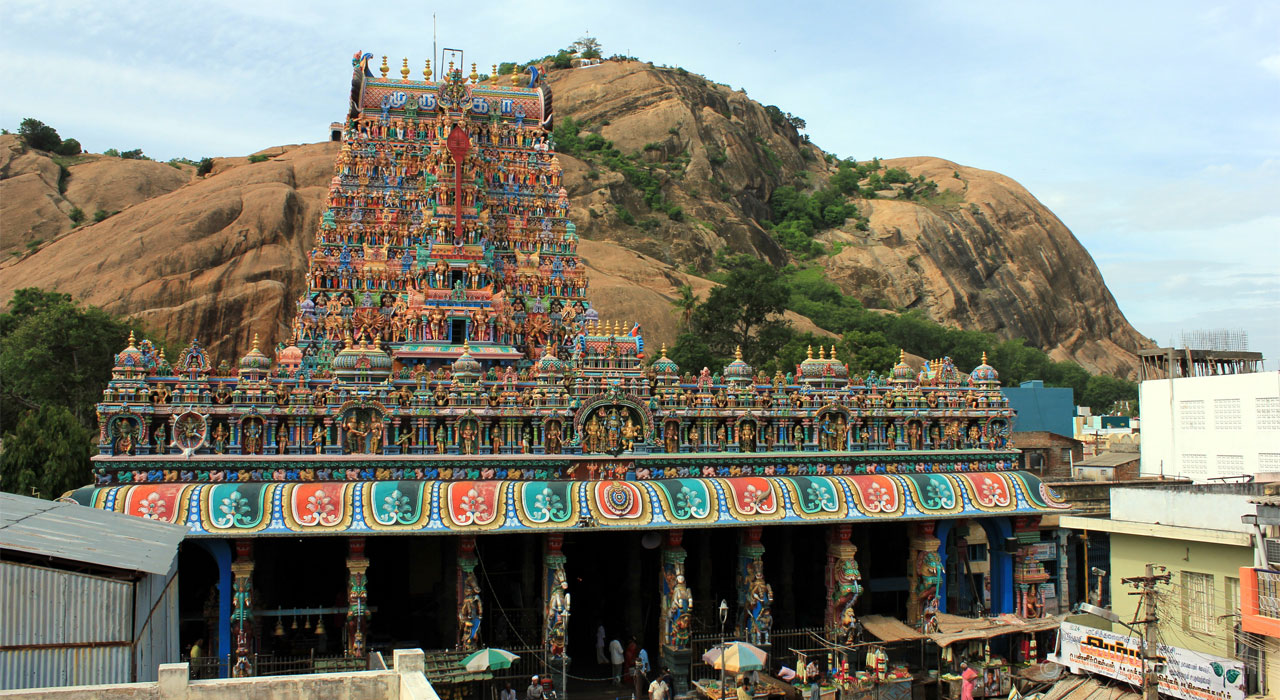
It is 8 kms from Madurai Junction. Cave shrines are calculated as 8th century creation of the Pandiyans and the temple of the later Nayaks. One of the Six Special Abodes of Lord Murugan dedicated to Lord Subrahmanya is located here. The Sanctum Sanctorum is carved out of a single rock and the temple is believed to be in existence for many centuries. The walls and the pillars are carved with Sculptures that still fascinates the visitors.
Azhagar Kovil
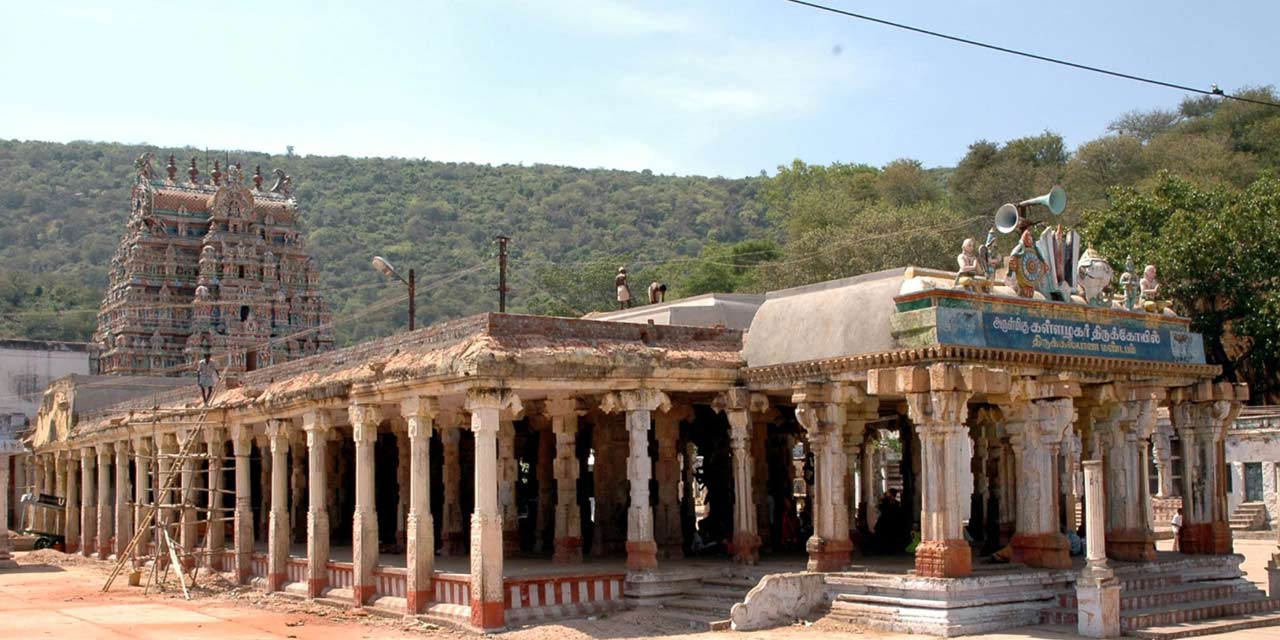
This Temple dedicated to Lord Vishnu called as Azhagar Kovil is located here, just 18 kms from Madurai Town. Ruins of an ancient fortified town can be seen around this temple even today. Temple underwent renovations and additions during the timeline of its existence. It is said that Yudishtra and Arjuna visited this temple during Mahabaratha period. Koorathazhwar, a disciple of Vaishnavite saint Ramunaja regained his lost vision here. The temple has the shrine of 2000 year Sudharsana-Chakra worshipped by thousands of devotees. Skandapuranam, Thirumurugatrupadai of Poet Nakkeerar and Arunagiri Nathar’s Thirupugazh reveres this holy shrine.
Solai Malai Temple [Pazhamuthir Solai]

This temple is on the hillock reachable by a 3 km trekking on the Azhagar Malai from Azhagar Temple. This is the only one among Murugan’s Aru Padai Veedu temples, where He graces the devotees with His consorts Valli and Deivanai. The wedding festival is celebrated along with Skanda Sashti festival. Pazhamudircholai is a temple located about 16 kilometres north of Madurai atop a hillock covered with dense forests. One of the six important abodes [Arupadai Veedu] and close to the famous Azhagar Kovil [Lord Vishnu] . Divine Poet Avvaiyar, while relaxing under the Naval Tree, encountered Lord Murugan in the form of Shepherd Boy on that tree, who played a prank with her to make her realize that Materialism should be removed from the mind to visualize the truth and seek God. It is also said that the actual temple was Azhagar kovil relocated as Pazhamuthirsolai by the then ruler of Madurai – Thirumalai Naicker of the Nayaks dynasty.
Tanjavur Temples
Historically speaking , The temples of Thanjavur are not as old or ancient as the temples of 108 Divya Desams or the 274 Saivaite Temples established and glorified by Alwars and Nayanmars respectively, between 7th and 9th Century. But they are majestic monuments of the past glory of the Chola Regime and famous for its excellent Architecture and Sculptural work. Thanjavur and the adjoining areas of Kumbakonam and Nagapattinam boasts of hundreds of important and ancient temples. Cholas, Pandiyas, Nayaks and the Marathas have contributed their might for making these areas to be called as Treasure House of Temples.
Punnainallur Mariamman
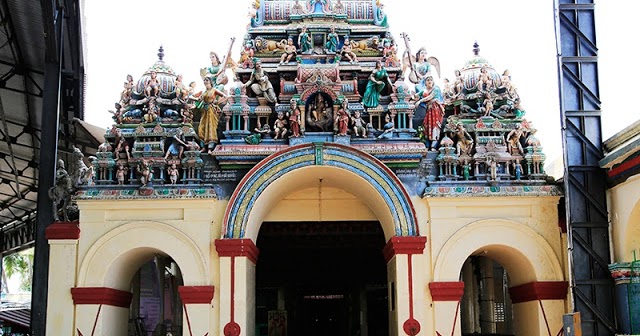
Lord Siva anointed Eight Sakthis [Ashta Sakthi ] to destroy Asura Tanjan. One such Sakthi on the eastern direction is Punnainallur Mariamman. A legend goes this way: The Maratha King Venkoji Maharaja went on a pilgrim to have darshan of Samayapuram Mariamman. Midway, he stopped to rest. In his dream Mariamman appeared and asked him to go to the forest of Punnai Trees nearby to look for her. The King rushed to the spot indicated to him and he saw a white-ant hill (Putru) and built a temple around it 1680. The Maratha rulers Tulja, Serfoji also worshiped and renovated the temple during their reign. Daughter of Tulaja Raja (1729-35) of Thanjavur, who lost her eyesight due to illness and regained it on offering prayer worship at this temple. The Great saint Sadasiva Brahmmendra, shaped the white-ant hill (Putru) in the form of Mariamman and installed a powerful Sri Chakra here.
Gangaikondaan Cholapuram [71Kms]
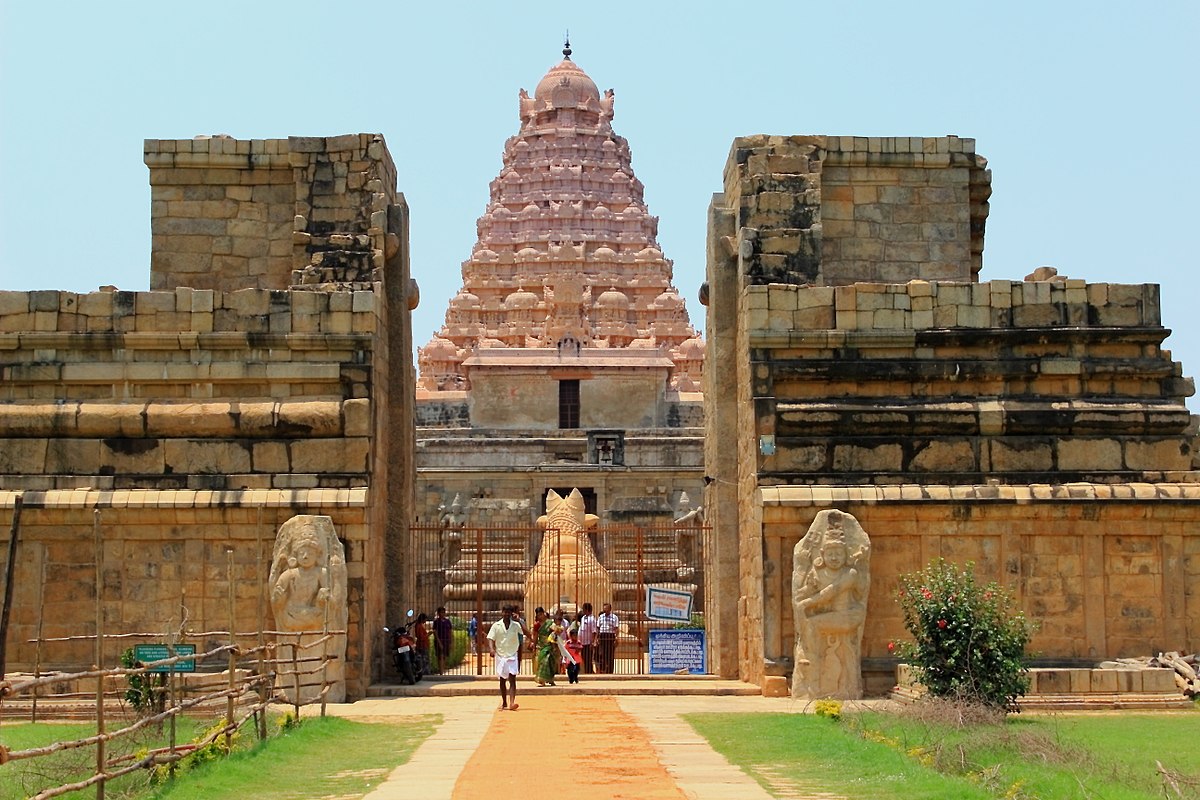
The town acquired this name either because Rajendra I during his campaign to the north, brought water from river Ganga in Golden Pot and sanctified the reservoir water body here. Hence he was given the title of 'Gangaikondan' (the one who brought the Ganges). The popular Siva Temple was built by Rajendra Chola at Gangaikondan Cholapuram and devotees call it an equal of the Big Temple. This area is filled with refreshing landscapes for miles around.
Thiruparangundram
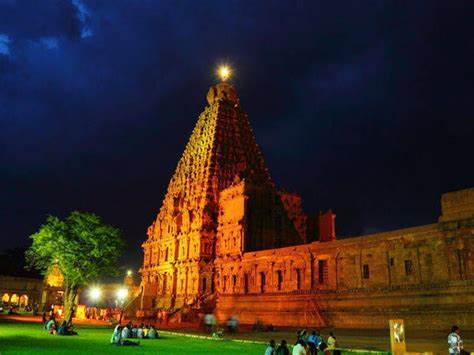
This popularly known as Thanjai “Periya Koil” [Big Temple]. The Great Chola Emperor Raja Raja Cholan I [985-1012], dedicated this temple to Lord Siva in the year 1010 AD . This temple celebrated its 1000th year of existence in the year 2010. It is located amidst fortified walls presumed to have been added in the 16th century. This great temple speaks about the architectural excellence of the region. The Tower above the sanctum Sanctorum is 216 feet tall. This tower is one of the tallest tower of its kind in the whole world. Kumbam or chikaram a bulbous structure above the tower cut out of one rock weighs almost 80 tons, is regarded as the show case of the Architectural Excellence of the period. It is believed that the Cupola / Sikaram was rolled up the incline built from the Village called Saara Pallam now called as Vayalur, more than 5 Kms from the BIG TEMPLE. The majestic tower and lifting the cupola to the top is a testimony to the engineering skill of the Chola Architects, who planned its construction in such a manner that the shadow of the Cupola does not fall on the ground. 12 ½ feet tall, 8 feet long and 5 ft wide sacred bull or Nandi made out of a single rock weighing 25 tons installed outside, in front of the sanctum Sanctorum. The Lingam is 13 ft tall, with a circumference of 54ft.
PAPANASAM [30 kms]
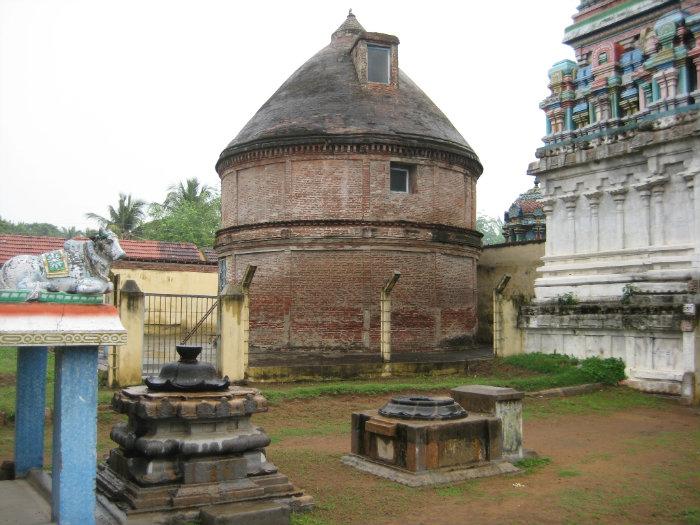
Palaivana Nathar Swamy temple constructed by the Cholas and legendry 108 Sivalangam temples have been established by Lord Rama after the war against Ravana, are the two important temples of this area. The granaries here are specimen of effective storage system of Grains. There is a Granary, constructed by Nayaks of 16th century which is 36 ft tall and can hold a capacity of 3000 kalam [ unit of measure] of grains. The State Archaeological Department has declared it as a monument.
Rameswaram Temples
Rameswaram is a small Island and Major Pilgrim Centre in the Gulf of Mannar. It is connected to the mainland by Pamban Bridge. On his return from Ceylon after Ravana Yudhdham ( war ) in Lanka , Sri Rama offered his repentance prayer to Lord Siva to absolve his sins that he had committed by Slaying Ravana. Every day, this island receives thousands of pilgrims for all parts of the Indian Sub Continent to get absolved of their sins and also perform rituals for their ancestors. This is at par with Varanasi or Benares in sanctity of the North India.
Sri Ramanathaswamy Temple
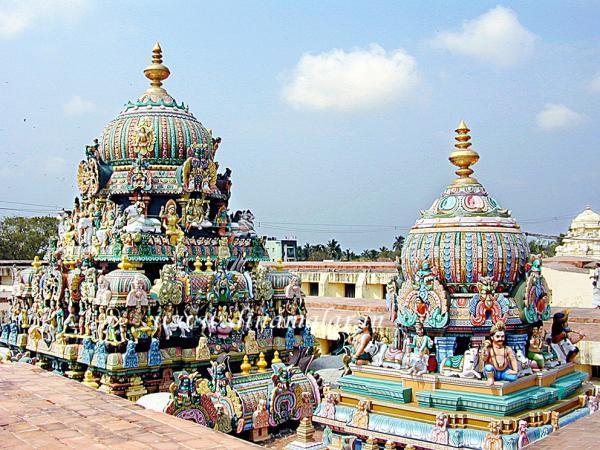
This temple is located near the sea on the eastern side of the island. It is well known for its architectural beauty of magnificent Prakaras or corridors with massive sculptured pillars on either side. 197 mts corridor East to West believed to be the longest in the world and another corridor of 133mts wide from South to North. This temple has undergone sea of changes from 12th century under the reign of different rulers. Special Pooja is performed every day to the Spatikalingam [ crystal lingam] installed by Adi Sankara in this temple. There are two lingams in the Sanctum Sanctorum. One brought by Hanuman from Kailash called Vishwalingam and other one built by Sita called Ramalingam. As instructed by Rama it is Vishwalingam gets First Pooja attention even today.
Agnitheertham
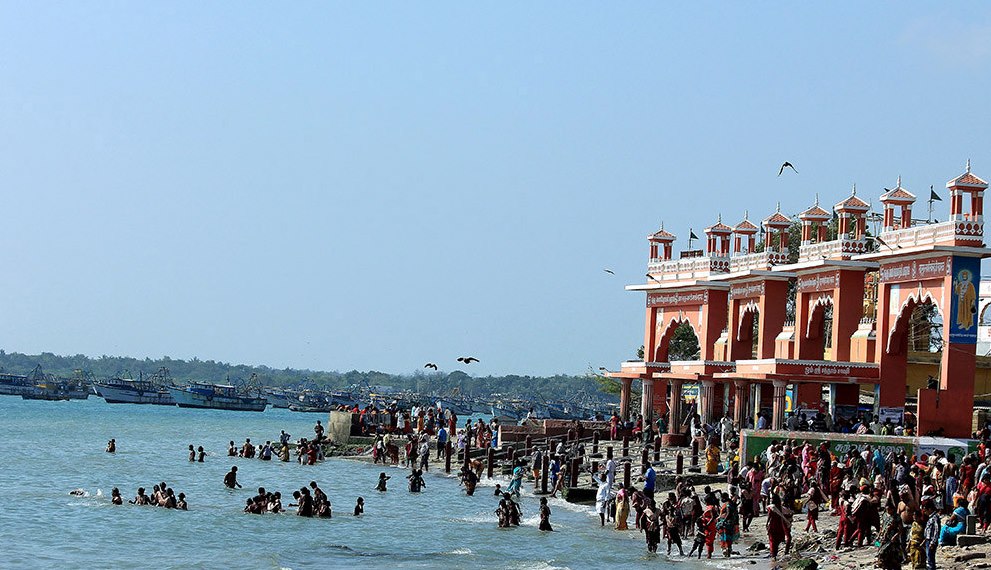
Sri Ramanathasamy temple faces the Theertham on the eastern side. The shore is only about 100 mts from the temple. The sea is very calm and peaceful. Since it is considered sacred it is called Agni Theertham because agni is considered to be purified element. Poojas and Rituals are performed to please the ancestors in this shore area. Devotees of Lord Siva take a dip in the agni theertham to wash away their sins.
Gandamadana Parvatham

It is a hillock situated 3 kms away and is the highest point in the island. From here one can see the imprint of Lord Rama’s feet on a chakra. The entire island of Rameswaram is visible from this point.
Sugreevar Temple / Theertham
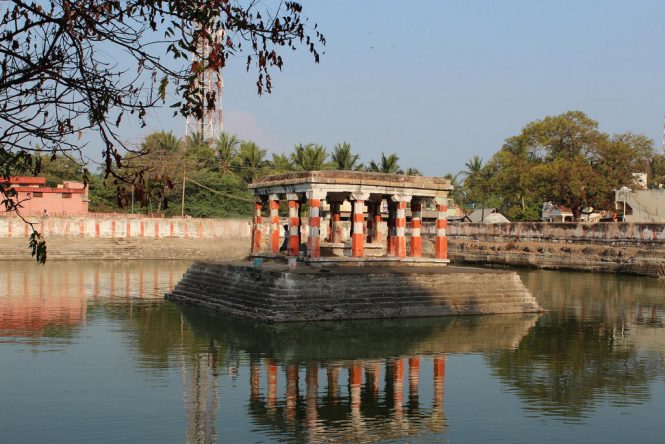
It is situated on the way to Gandamadana Parvatham near the Doordarshan Kendra. Sugreeva is the younger brother of vali of Ramayanam..
Jada Theertham
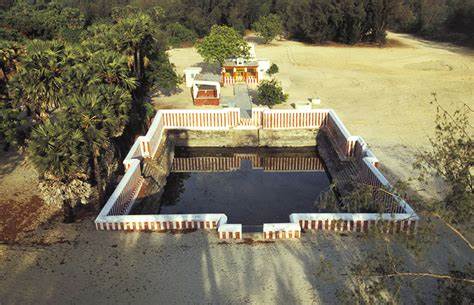
It is located 3 ½ kms from Rameswaram. It is believed that, Rama on his return from Lanka after Ravana Vadham, washed his Jada [hair] in this theertham to purify him before proceeding to worship Ramalingeswarar.
Nambu Nayagiamman Temple
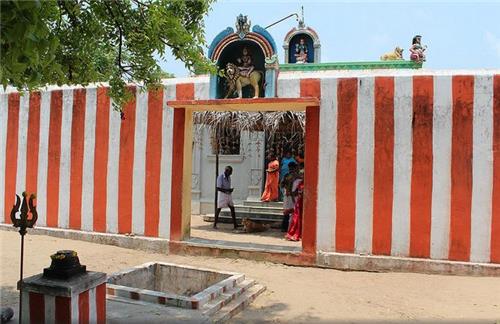
This temple is greatly venerated by the people of Ramnad District. It is situated 8 kms from the main temple in Rameswaram on the way to Dhanushkodi.
Satchi Hanuman temple
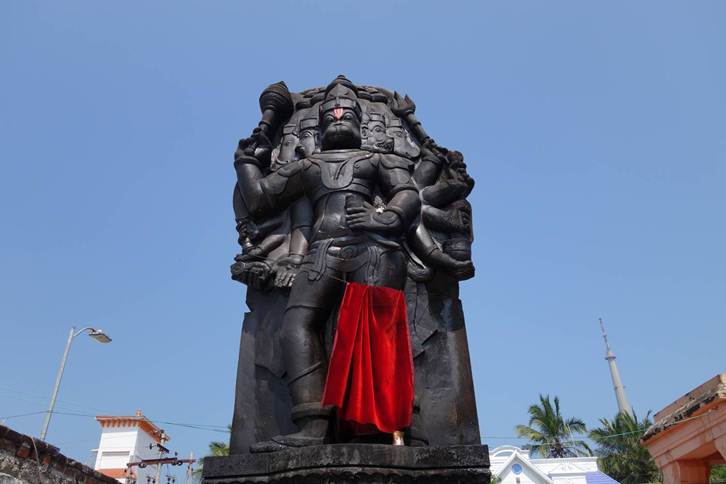
It is 3 kms from the main temple, on the way to the Gandamadana Parvatham. This temple Is the place where hanuman delivered the good news of finding Sita with the Choodamani a jewel that belonged to Sita as Satchi [evidence] to Rama. Hence it is called Satchi Hanuman Temple
Badrakaliyamman Temple
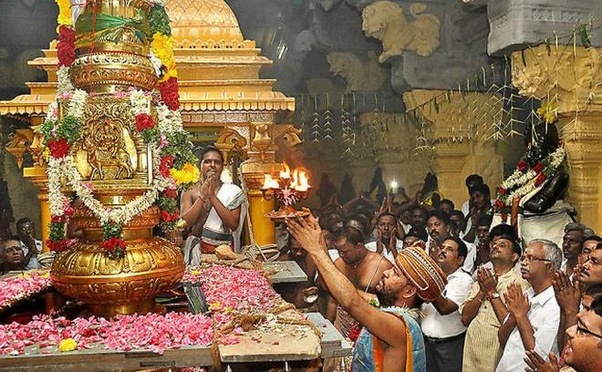
This is a temple for Devi Durga around 2 kms from the main temple on the way to Gandamadana Parvatham.
The PANCHAMUGA [Five-Faced ] Hanuman Temple

It is located just 2 kms from the main temple, the deity of the hanuman is drawn with senthooram (Vermillion). Idol of Lord Ram, Sita and Hanuman brought from Danushkodi during the 1964 cyclone are placed there. The Floating Stone used to build the Sethu Bandhanam or the bridge between India and Lanka too can be found in this temple.
Kothandaramaswamy Temple
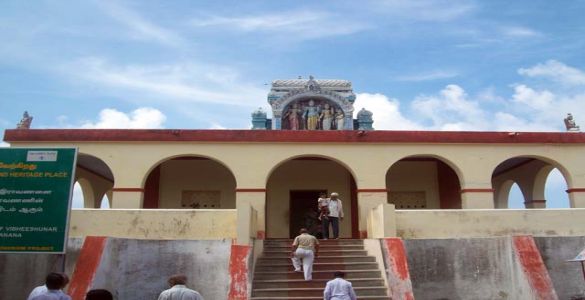
This temple is 12 kms from Ramewswaram. According to a popular belief, it is at this place, Vibhhishanan [brother of Ravanan] surrendered before Rama.
Dhanushkodi
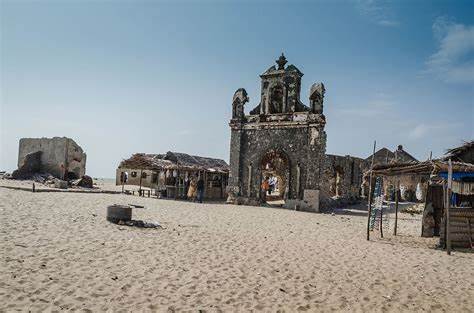
It is 18 kms from Rameswaram temple. It is the southern most tip of the island. Danushkodi was completely washed away in the 1964 cyclone. Tourist can witness the remains of the devasted town. Tourist go for surfing here.
Kumbakonam Temples
Kumbakonam is one of the ancient temple town picturesquely located amidst the two rivers Cauvery and Arasalar. In olden days it was called Thirukudamookku and it is also popularly called as Kudanthai now. It is popular for the Divine Tank in the heart of the city where Mahamagam Festival takes when lakhs of pilgrims from all over Tamil Nadu converge here to take dip in the tank at the auspicious hour. All the deities of the temples in and around turnout here to have dip at that time too. This festival falls in the month of Masi [Feb-Mar] on Magam Star Day. The town reached the peak of its property during the British Period and it was a prominent centre of European education and Hindu culture and it assumed the name as the ‘Cambridge of South India’.
Adi Kumbeswarar temple
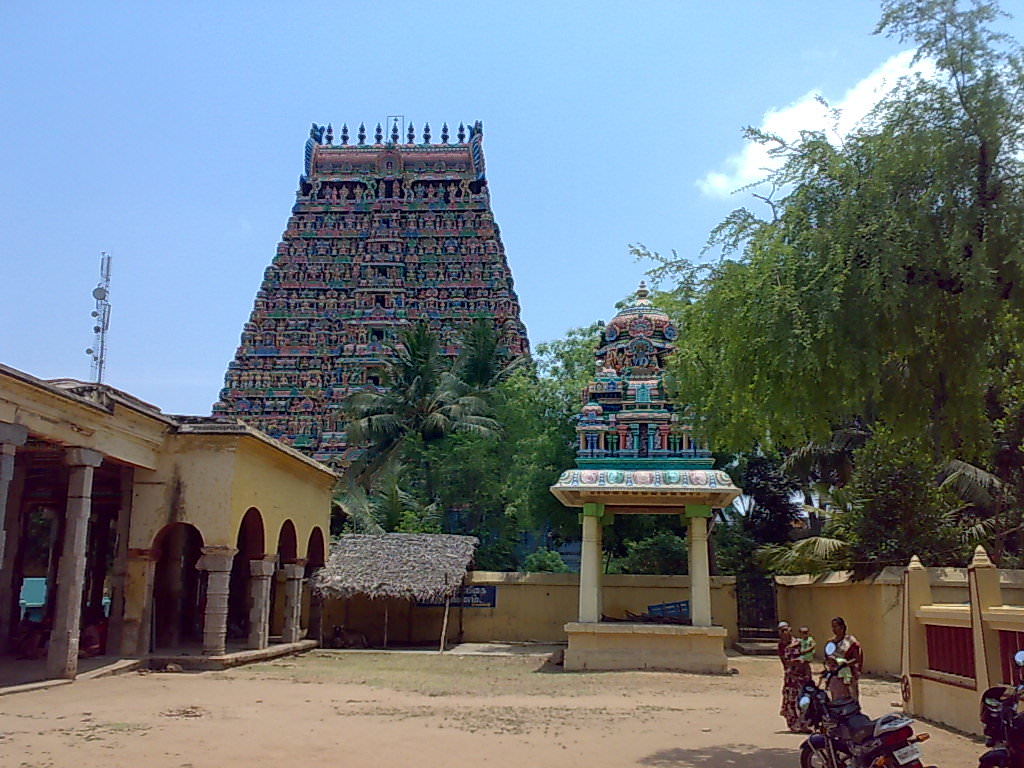
It is one among the important temples dedicated to Lord Siva. It is a padal petra sthalam ( glorified by saints and Nayanmars ). This temple complex is 2800 m2 in area and has Four Gateways or Towers on all four sides, the tallest being the 11 stage , 30 m tall tower on the eastern side. Apart from the presiding deities of Kumbeswarar and Mangalambigai Amman many shrines are located in this prominent temple complex. The sixteen-pillared hall built during the Vijayanagar Period has all the 27 stars and 12 zodiac signs carved in a single stone. Masi Magam festival is the important festival of the temple. 9th Century Chola Dynasty and the Thanjavur Nayaks made remarkable contribution to the development of temple.
Sarangapani Temple
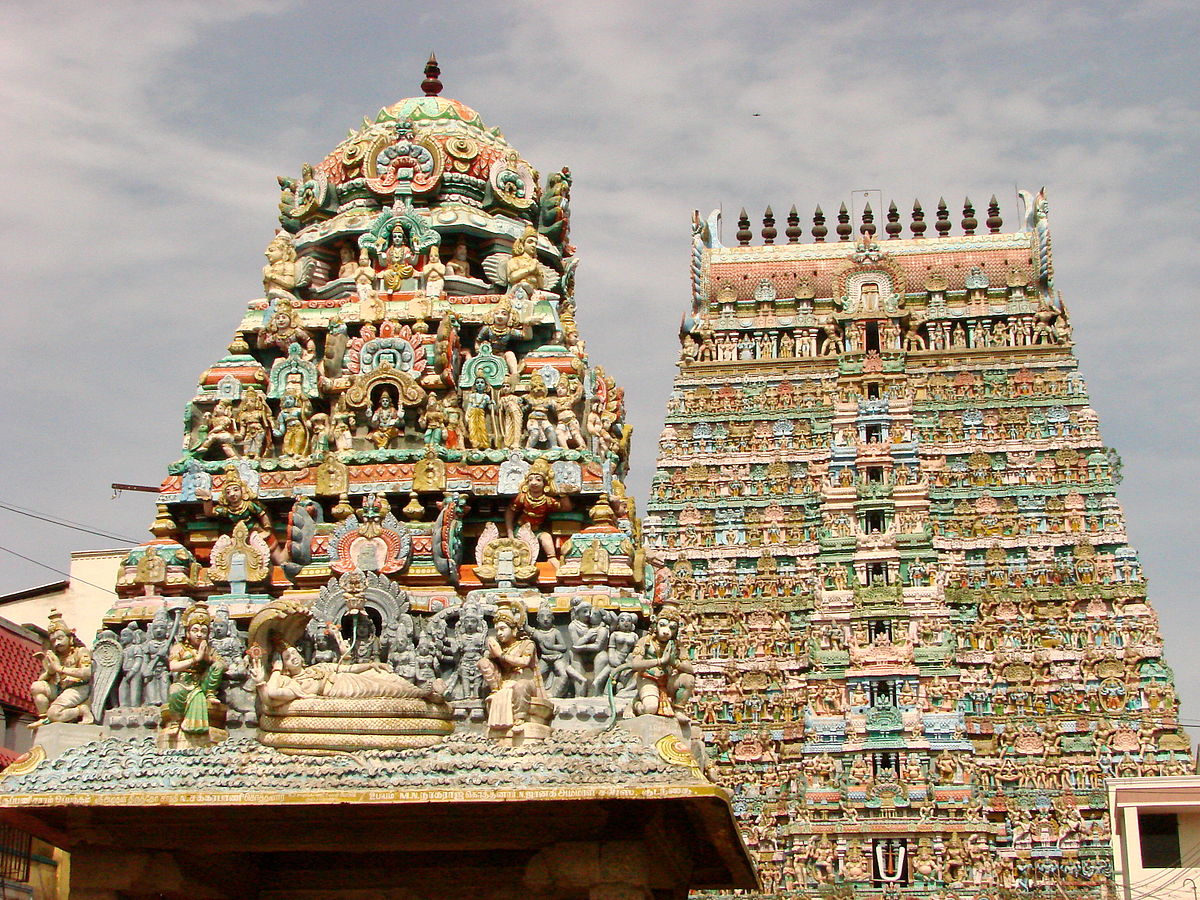
It is near the Uchipillaiyar Kovil junction at Kumbakonam. Lord is Sarangapani / Aravamuthan and Goddess is Nacciyar Komala Valli. It is one of the 108 Divya Desam glorified by the Alwars of Vaishnavite sect and also classified as one of the Pancharanga Kshetram on the banks of Cauvery. Medivial Cholas, Vijayanagar and Madurai Nayaks have developed this temple during their reign. Lord Sarangapani is in reclining position called as Udhana Sayana. 175 feet tall, 11 Tier Raja Gopuram or the tower is the highlight of the temple. The temple tank called as POTRAMARAI KULAM is located on the western side. Sanctum Sanctorum is made up with 12 columns, shaped like a chariot. Sarangapani believed to have appeared and blessed Saint Hemarishi here. Chariot Festival is the most colourful festival of the temple in the month of Chithirai [Apr-May]. The chariot is said to be weighing 300 tons.
Someswara temple
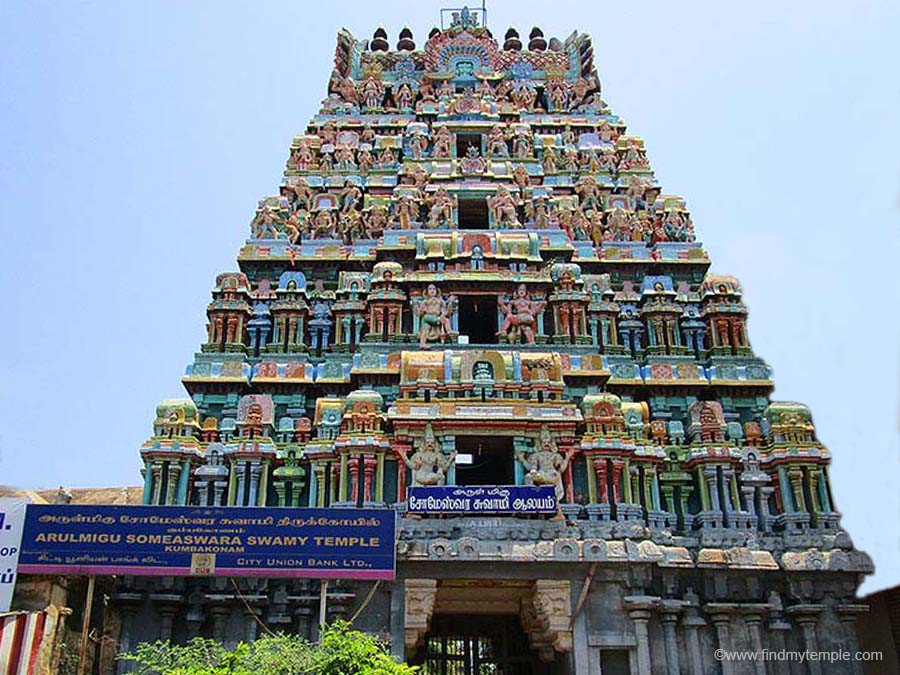
This temple is located on the south of Sarangapani Temple. It faces the North and there is abig tower or Gupuram on the eastern side. The architectural style and element of this temple resembles the Dravidian Architecture of the 13th Century of the Chola Regime. Aravamuthar and Thenar Mozhi thayar are the other deities enshrined in this temple complex.
Nageswaran temple
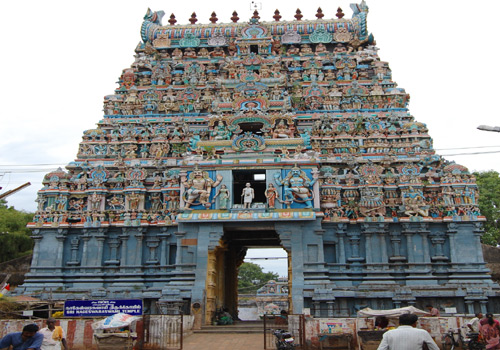
This temple was built by Aditya Chola during the 9th Century. This temple has Pralayakala Rudra Sannidhi. Adisesha and Surya had worshipped Sri Nageswara here. It is also a Rahu Parihara Sthalam. A legend has it that the mythological serpents Adiseshan, Dakshan and Kaarkotakan worshiped Lord Siva here. The orientation is structured in such a way that it allows sunlight inside the temple, right on the sanctum sanctorum only during the Tamil month of Chithirai (April/May). It is also called Surya Kottam or Keezha Kottam. It is said that Sanctum Sanctorum of both Nageswaran temple and the Sarangapani Temple are similar in the form of a chariot. The temple consists of three gopurams on the Eastern, Western and Southern sides. There is a local belief that, visiting Nageswaran Temple, Tirunageswaram and Thirupampuram in the Morning, Afternoon and Evening has significant meaning for Rahu Dosha Pariharam. First three days of Tamil Month Chithirai [Apr-May] the sun rays falls directly on the base of Sanctum Sanctorum.
Ramasamy Temple
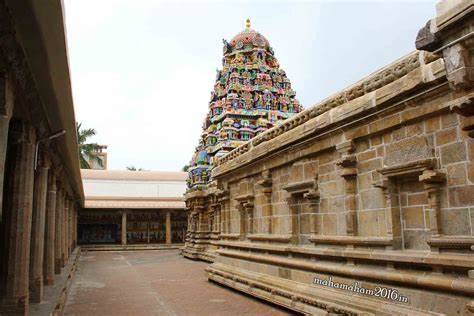
This temple was built in the 16th Century by King Achutha Nayak of Thanjavur. It is located on the South East of Potramarai Kulam and South of Uchipillaiyar Koil. The temple has a 3-tiered Gopuram. Shrine of Sri Rama with Vyakara Mudra seated with Sita has been installed in the Sanctum Sanctorum. Lakshmana, Bharatha and Chatruguna is in standing posture next to Rama and Hanuman kneeling down holding the Manuscripts. The Outer Court has pillars sculpted with finesse, various sequences of Ramayana and each pillar is carved out of a single rock. Paintings of Pattabishekam[coronation] of Vibishnan and Sugriva; Hanuman playing the Veena, Agalya getting relieved of the curse too are found in the temple. The temple is a typical Nayak style of temples. One can read the Chitra Ramayana On the walls of the Sanctum Sanctorum while going around the Sanctum Sanctorum.
Chakkarapani Temple
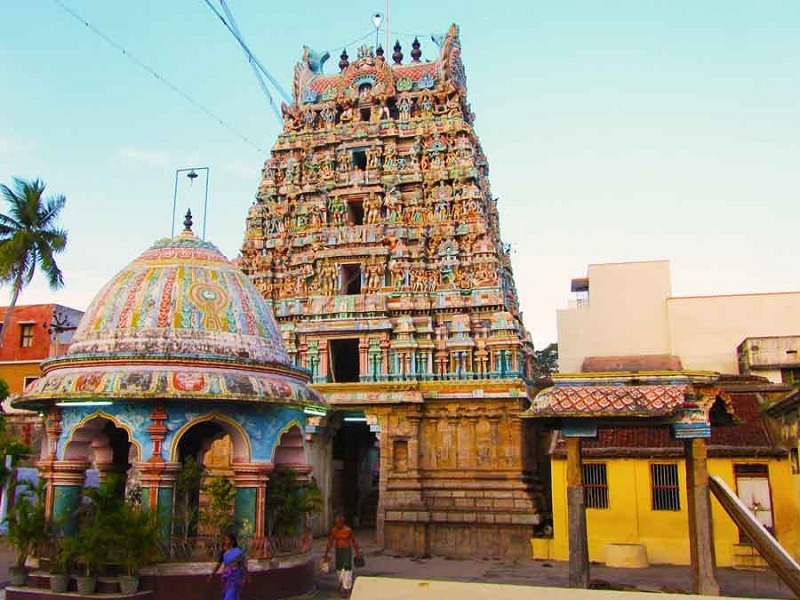
The Temple is the solitary temple complex for Sri Chakrapani . Chakrapani other wise called as Sakarathazhvar, is on the north of the Periya Kadai Veethi [Big Bazaar Street] on the southern Bank of River Cauvery. It is believed Lord Vishnu appeared in the form of Sudharsana Chakra to put down the arrogance of Suryan. It is said the Chakrapani has the third eye like Lord Siva. The Second biggest vaishnavite temple of Kumbakonam. Agampara Vinayakar, Panchamuka Anchaneyar and Thayar Vijayavalli are enshrined here in this complex. Utharayanam [Thai – Aani] and Dakshinayanam [Aadi – Panguni] have two different entrances to worship Sarangapani in the Sanctum Santorum. They are called as Dakshinayana Vayil [gate] and Utharayana Vayil (gate). The outer court adjoining the Sanctum Sanctorum has been designed like a balcony.
Kambatta Viswanathar
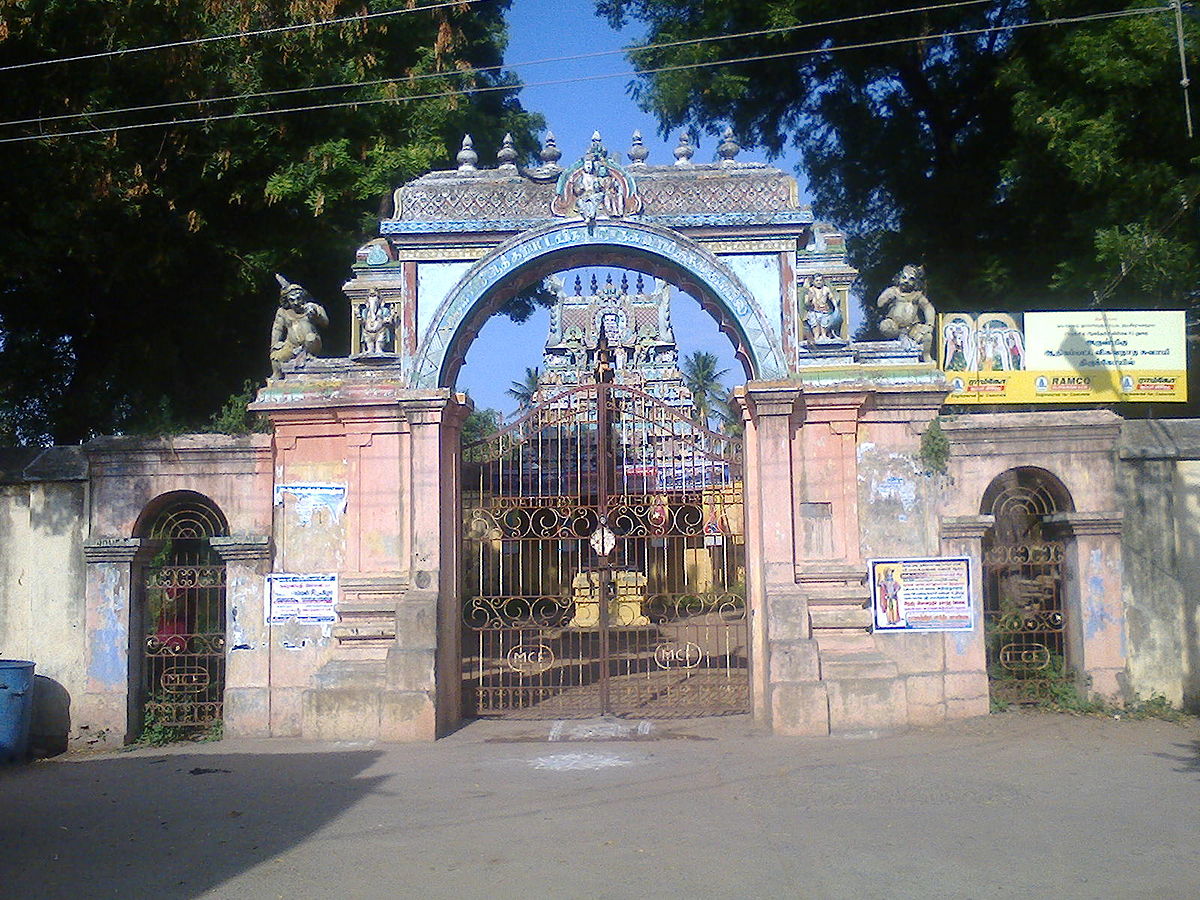
Pettai Adhi Kambatta Viswanathar enshrines the presiding deities of Kambatta Viswanathar and Anandha Nidhiambigai. It is located on the south of Adi Kumbeswarar Temple. It is called as Malathi Vanam also. This temple is also called as Kambatta Viswanadhari because the coin minting was done here during Nayaka Period. It is believed the famous saint ‘Thoomakethu’ found this temple.
Pana Pureeswarar Kovil
This is relatively a smaller temple complex located amidst the Panapuri Agraharam in the heart of the town. Veda Vyasar is believed to have visited this temple and worshipped the Lord Here.
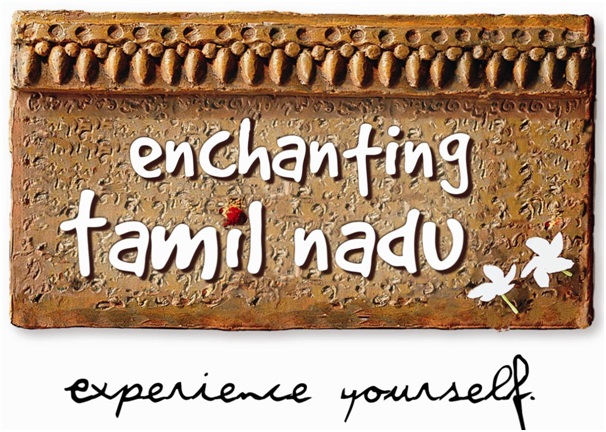
Best Selling Tour Packages
Charming Hills Coastal Odyssey Southern Triangle Cultural Carnival Pilgrim Blessing Heritage Magic Wild Hills Misty Hills
Honeymoon Tour Packages
Extreme Privacy Romance @ Hills Amazing Love Love @ Coast Romantic Honeymoon Romantic Bug
Hill Station Tour Packages
Mist Valley Enchanting Hills Morning Drizzle Hills & Wildlife Wandering Hills Weekend Hills
Beach Tour Packages
Beach Fantasy Pristine Beaches Beach Wanderlust Sun N Sand Romance @ Coast Beach Nomad
Wildlife Tour Packages
Go Wild Love Tiger Amazing Wild Extreme Wilderness Wild @ Hills Wandering Wild
Temple Tour Packages
Temple Darshan Majestic Temples Magnificient Temples Historical Temples Temple Pilgrimage Vibrant Temples
Historical Tour Packages
Historical Splendor Historical Grandeur Historical Spectacle Historical Marvel Historical Glory Historical Beauty